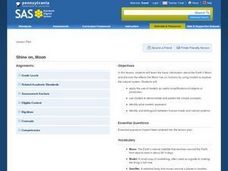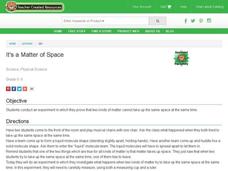Scholastic
Lesson Three: The Earth, Movement in Space
If you feel like you're standing still, you're wrong! The Earth is constantly rotating and orbiting under our feet. Demonstrate the Earth's movement within the solar system with a collaborative activity. With a candle or lamp in the...
NOAA
Plate Tectonics II
Mid-ocean ridges, rift valleys, island arcs, mountain ranges, earthquakes, volcanoes ... there are so many features associated with plate tectonics. The 14th installment of a 23-part NOAA Enrichment in Marine sciences and Oceanography...
Curated OER
Shine On, Moon
Students explore space science by conducting an experiment in class. In this Moon instructional activity, students define a list of space science vocabulary and read the book The Moon. Students utilize shoeboxes and string to conduct a...
Curated OER
Space-Age Experiments
Students evaluate the notion of aging by reviewing some of the studies that occurred on John Glenn's space shuttle mission.
Curated OER
Greenhouse Effect: Pop Bottle Experiment
Students explore global warming by conducting a weather experiment. In this greenhouse gas lesson, students define the greenhouse effect and the impact on our ozone layer. Students utilize a soda pop bottle, floodlight bulb, thermometers...
Curated OER
Making Regolith
You may not be able to take a field trip to the moon, but that doesn't mean your class can't study moon rocks. Using graham crackers as the moon's bedrock and powdered donuts as micrometeorites, young scientists simulate...
Curated OER
Testing for Life’s Molecules
Want to hear a joke about sodium? Na. Young scientists test various materials to identify if they include protein, starch, and glucose by using the Biuret test, iodine starch test, and Benedict's test respectively. After practicing with...
Curated OER
Sky 2: Shadows
Students explore space science by participating in a shadow experiment. In this sky observation lesson, students identify how the sun creates different sized shadows by moving across the horizon. Students utilize yard sticks, markers,...
Curated OER
NASA Robots
Learners investigate how robots are used in space. In this space science lesson, students participate in an experiment using a blindfold and complete assigned tasks. The learners demonstrate how robots are "thinking" machines.
Curated OER
Science and Careers
Students investigate how knowledge of science influences people in their daily lives, specifically in their careers. Students conduct interviews with an individual in a science or technology career as part of their research on the impact...
BioEd Online
Center of Gravity
Between the pull of gravity and the push of air pressure, it's a wonder animals can balance or move at all. With a hands-on lesson about the center of gravity, learners discuss their own experiences with the topic, then work with...
BioEd Online
Good Stress for Your Body
Stress the importance of the different types of pressure our mind and body experience in a lesson about how certain types of stress are actually necessary and good for our bodies. As astronauts and people with injuries can attest, not...
BioEd Online
Bone Structure: Hollow vs. Solid
What is meant by the phrase "form follows function?" Allow your budding biologists to discover first-hand through two activities. In the first, groups work together to discover whether a solid cylinder or an empty cylinder can support...
BioEd Online
Muscle Fibers
What better way to learn about muscle than by dissecting one? Using cow muscle (beef), learners compare bundles of yarn to muscle fibers as they explore each. The supplemental reading about astronauts losing muscle mass in space and what...
Scholastic
Lesson One: The Earth, Background and Glossary
How much do you really know about our planet? Middle schoolers build up their prior knowledge about Earth, its placement in the solar system, its composition, and important geological vocabulary with an introductory earth science lesson.
Curated OER
Will It Sink or Float?
Learners conduct a science experiment to determine whether a variety of objects will sink or float. They discuss the concept of density, and then make predictions about whether the objects will sink or float. They then conduct the...
Curated OER
Health Issues Related to Space Experiments
Learners participate in a science lesson that integrates connections between health issues on Earth and how those issues are related to studies conducted on the International Space Station. T
Curated OER
Simple Rocket Science
Young scholars demonstrate Newton's Third Law of Motion. They discuss the history of rockets, observe how a rocket works, and draw a picture and write an explanation of the balloon experiment.
Curated OER
Science:Effects of Weathering
Seventh graders take an outdoor observation walk around the campus and take soil samples. Working in groups , they conduct experiments with rocks and soil that demonstrate the effects of different types of erosion.
Curated OER
Just a "Fellow Traveler" in the Human Experience
Students connect the events of early space exploration to their lives today. After viewing a teacher created gallery, they discuss how the launch of Sputnik and how space exploration in general has positively or negatively affected...
Curated OER
Space Program Spin-Offs
Students brainstorm types of accommodations needed for space travel. They create a table of categories for these accommodations and work in groups to research the categories. Each group puts together a five minute presentation to present...
Curated OER
People and Space
Students eat dehydrated foods that the astronauts would eat in space. In this dehydrated foods lesson plan, students make lists of food they could eat, discuss how dehydration takes place, eat food, and complete discussion questions.
US Environmental Protection Agency
Sea Level: On the Rise
With the global temperature on the rise, the effects of climate change are starting to be seen. However, many people have a difficult time conceptualizing the long-term effects, such as sea levels rising. Given an easy and effective...
Curated OER
It's a Matter of Space
Students explore matter. In this physical science lesson, students role play the 3 states of matter forming "liquid" molecules and "solid" molecules with teammates. Students perform an experiment in which the result illustrates that two...























